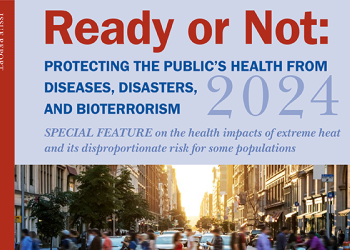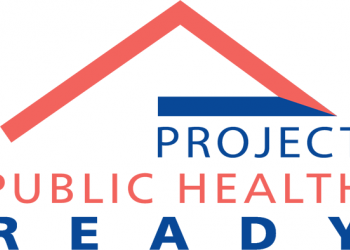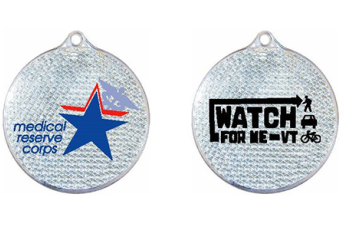Behavioral health is an essential part of community resilience and recovery from traumatic events, after which individuals and first responders may experience a range of emotional, behavioral, physical, and cognitive responses. Individuals who had a mental illness (whether diagnosed or not) prior to the event may experience re-triggering or increased severity of symptoms, which could be exacerbated by decreased access to behavioral healthcare and/or medications following a disaster. While many individuals are resilient and will recover on their own, others may require additional support.
As the “boots on the ground” before, during, and after disasters, local health departments are uniquely positioned to help cultivate community resilience and help address the behavioral health impacts of disasters. Local health departments work alongside behavioral health providers, social service organizations, trained volunteers, and the federal government to ensure that individuals in their community can access behavioral health services before and after disasters, monitor the behavioral health impacts of disasters, share information and resources with the public, and direct those experiencing trauma to appropriate resources. Local health departments are also responsible for taking steps to ensure the health and safety of health department first responders, including identifying risks and monitoring responder behavioral health needs, facilitating training, and coordinating with partners to provide access to behavioral health services as needed [1].
While local health departments play a key role in addressing behavioral health concerns, they require strong partnerships with the broader public health, behavioral health, healthcare and emergency management communities to meet the needs of individuals with mental illness before and after disasters. Behavioral health should be included in all phases of preparedness planning, response, and recovery. One way that the preparedness community is formally engaging behavioral health in preparedness planning, training, and exercises is through healthcare coalitions. The National Association of County and City Health Officials’(NACCHO) 2018 Preparedness Profile Assessment found that about 60 percent of local health departments report that behavioral health providers are represented in their coalition [2]. NACCHO recommends that all coalitions include behavioral health providers. Further, about half of local health departments consider their partnership with behavioral health providers to be “good” or “excellent,” which is consistent with findings in 2015 and 2016 [3]. While this represents a significant investment in, and recognition of, the importance of disaster behavioral health, there is still room for improvement.
Mental/Behavioral Health Resources
NACCHO is committed to supporting local health departments in their efforts to work with partners to improve the behavioral health of their communities before, during, and after a disaster. Below is a list of disaster behavioral health resources compiled from a variety of sources for local health departments.
Trainings
- Building Workforce Resilience through the Practice of Psychological First Aid – A Course for Supervisors and Leaders is a free 90-minute interactive online training video that helps public health leaders understand and address their staff’s stress risks and reactions to create a resilient workplace (NACCHO).
- Psychological First Aid Online – a six-hour course for individuals new to psychological first aid and practitioners who want a refresher (National Child Traumatic Stress Network).
Planning Resources
- NACCHO’s Toolbox contains a variety of disaster behavioral health resources, including example disaster behavioral health response plans, recovery plans, tools and templates for family assistance centers and points of dispensing, and guidance around legal and ethical considerations for mental and behavioral health planning.
- CDC has compiled planning resources for state and local governments to help them include mental health management throughout each phase of a disaster.
- Mental Health All Hazards Disaster Planning Guidance provides direction and support for state and local mental health leaders as they create and/or revise all-hazards response plans (SAMHSA and the National Association of State Mental Health Program Directors).
- Fact sheet: Tips for Health Care Practitioners and Responders: Helping Survivors Cope with Grief after a Disaster or Traumatic Event (SAMHSA).
- NACCHO, in collaboration with the Northeast Texas Public Health District and El Paso Department of Public Health, developed two behavioral health videos designed for use in points of dispensing. Presented in English and Spanish, with closed captioning and on-screen American Sign Language interpretation, these videos are designed to help first responders, children, and the general public manage and cope with stress after disasters or traumatic events.
- SAMHSA has developed several tip sheets that local health departments can share with the public on coping with grief and re-traumatization following a disaster or traumatic event.
Federal Resources and Technical Assistance
- SAMHSA’s Disaster Technical Assistance Center works to prepare states, territories, and tribes to deliver effective behavioral health response to disasters; they can be reached at [email protected] or 800-308-3515.
- The Crisis Counseling Assistance and Training Program (CCP) provides supplemental aid to support mental health assistance and training activities during presidentially declared major disasters (FEMA).
- ASPR’s Technical Resources, Assistance Center, and Information Exchange (TRACIE) website has compiled open source scholarly and vetted resources for responder behavioral health and resilience in the responder safety and health topic collection.
[1] Centers for Disease Control and Prevention (2011). Public Health Emergency Preparedness Capabilities. Capability 14: Responder Safety and Health. Accessed on May 15, 2018 from https://www.cdc.gov/phpr/readiness/00_docs/DSLR_capabilities_July.pdf
[2] National Association of County and City Health Officials (2018). 2018 Preparedness Profile Assessment. Unpublished raw data.
[3] National Association of County and City Health Officials (2018). 2018 Preparedness Profile Assessment. Unpublished raw data.








